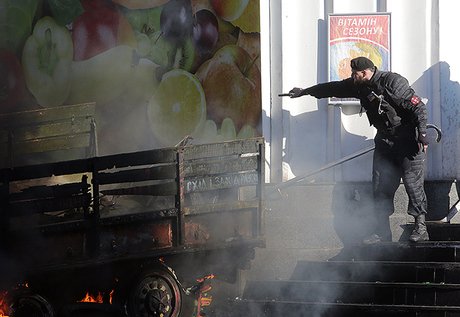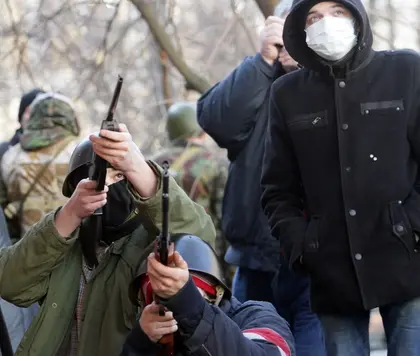At the same time, the government has not made any meaningful steps towards a peaceful resolution of the deadly conflict beyond declarations that President Viktor Yanukovych is ready for more negotiations with the opposition.
The political gridlock is fueling fears that a new spiral of violence may be imminent.
JOIN US ON TELEGRAM
Follow our coverage of the war on the @Kyivpost_official.
Protesters attacked a number of government buildings in western Ukraine on Feb. 18 during mass unrest in western Ukraine, including three regional Security Service of Ukraine departments in Lviv and Ternopil and seized the Ivano-Frankivsk department, according to Volodymyr Borodko, the deputy head of the law enforcement agency known more commonly by its SBU nickname.

“The attackers did not take into account the fact that buildings contained limited access documents, special investigation equipment and weapons,” Borodko said.
He said 267 pistols were seized by the protesters, as well as two rifles, three machine guns, 92 hand grenades, and about 15,000 pieces of ammunition.
Serhiy Burlakov, a representative of the Interior Ministry, said that also close to 300 piece of arms were stolen from police departments in Ivano-Frankivsk, Lviv, Rivne and Ternopil regions that were also taken over.
In a separate statement, the SBU said protesters since yesterday have seized more than 1,500 guns and 100,000 rounds of ammunition, which they have used “to commit murders and take hostages,” the service said in a statement.
A new attempt to take over the police department in Khmelnytskiy took place on Feb. 19, the Interior Ministry said.
The law enforcers have started criminal investigations of the takeovers, while the SBU alerted its anti-terrorist units. Also, at least one unit of the army’s paratroopers was moved to Kyiv, according to the defense ministry.

Opposition interpreted these moves as preparation for a new crackdown on EuroMaidan protesters after failure to clear the protesters off the street on the night of Feb. 18. Police units were stopped from advancing when a water cannon and at least one armored personnel vehicles were set on fire by the protesters.
But death toll from violent clashes that continued all day and most of the night was at least 26, and more than 1,000 people were reported injured on both sides, including over 350 law enforcement officers, Burlakov said.
EuroMaidan’s information department sent out an alert on Feb. 19, saying that a new attack by the police is planned at night. During the day, protesters stocked up on Molotov cocktails and rocks and cobblestones dug out of the pavement on Maidan Nezalezhnosti and surrounding streets.
They also took over the central post office building to compensate for the loss of their bases in Trade Union House, which burned down on Feb. 18 and two other buildings nearby, which were taken over by the police.
At a briefing with diplomats, Foreign Minister Leonid Kozhara said that protesters were also transporting weapons from western Ukraine to Kyiv to use in future combat.
“I would like to refer to an episode on TV last night where leader of the Right Sector in Rivne Oblast, and he directly admitted that his organization planned and controlled the seizure of regional governments, and moreover, he said that the seized weapons and military vehicles will be sent to Kyiv to use in protests,” Kozhara said.
But Arseniy Yatseniuk, leader of Batkivshchyna, denied that protesters had any weapons. “We categorically to do support anyone who has weapons,” he said.
The Right Sector had previously called on all legal gun owners to join EuroMaidan and protect the protesters from police guns. The Interior Ministry, however, has insisted that police has not been using guns, despite numerous video and photo evidence assembled by the media and protesters.
Burlakov suggested that most of the hundreds of gunshot wounds received by the protesters were actually shots from the back by fellow protesters.
In the meantime, signs came from across the country of government losing control over parts of the country.
The Lviv Oblast Council announced it no longer was taking orders from the central government. Also, an unidentified group of people was reported to build a barricade close to Krakovets crossing point on the Ukrainian-Polish border in Lviv Oblast.
They did not allow Ukrainians to cross, only letting out foreign passport holders and causing delays. It was not clear what their demands were, according to Henrik Litvin, the Polish ambassador to Ukraine.
The Right Sector said they set up a check point on Kyiv-Chop highway and examine most cars to make sure they had no Berkut and “titushki,” the slang term for government-hired thugs who roam Kyiv in gangs at night, attacking and shooting people around the perimeter of EuroMaidan. At least two people were killed on Feb. 18 by titushki, including a journalist of pro-government Vesti newspaper.
In the meantime, the government showed little signs of trying to settle the conflict beyond offers of negotiations. In his address to the nation in the early hours of Feb. 19, President Viktor Yanukovych blamed opposition leaders for instigating violence and saying they will carry responsibility for it.
He also said a compromise needs to be found. “We need to sit at the negotiating table and save Ukraine. Otherwise the future generations will not forgive us for running the state that has to belong to them, our heirs,” Yanukovych said.
But the previous round of negotiations, which took place in the middle of the night on Feb. 18, started badly and finished even worse.
After forcing opposition leaders Yatseniuk and Vitali Klitschko to wait for him for more than an hour, the president then blamed them for violence and deaths. Both leaders left negotiations because they felt no progress was being made, they told Ukrainian media.
Kyiv Post deputy chief editor Katya Gorchinskaya can be reached at [email protected]
You can also highlight the text and press Ctrl + Enter




